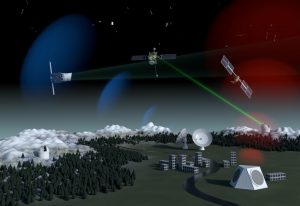The increasing demand for space-based sensing activities is driven by a variety of factors, reflecting the growing importance of satellite technology in numerous aspects of modern life. This demand spans across various sectors, including environmental monitoring, national security, telecommunications, and commercial enterprises. The need for precise, timely, and comprehensive data from space is propelling advancements in space-based sensing technologies and expanding their applications.
The Space Situational Awareness (SSA) Industry was valued at $1.5 Billion in 2021 and is estimated to grow from $1.6 Billion in 2023 to $1.8 Billion by 2026 at a CAGR (Compound Annual Growth Rate) of 4.6%. The major factors responsible for the growth of the satellite industry across the globe are the increasing use of small satellites for Earth observation, communication, and scientific research and the growing focus of space companies on the reduction of mission costs.
Environmental Monitoring and Climate Change
Climate Change Tracking:
Satellites play a critical role in monitoring the Earth’s climate. They provide essential data on atmospheric composition, ocean temperatures, ice sheet dynamics, and greenhouse gas concentrations. Instruments such as NASA’s OCO-2 (Orbiting Carbon Observatory-2) and ESA’s Sentinel satellites are vital for tracking carbon dioxide levels and understanding their impact on global warming.
Disaster Management:
Space-based sensors are crucial for disaster prediction, management, and response. They offer real-time data on natural disasters such as hurricanes, earthquakes, floods, and wildfires. The use of satellites for early warning systems and damage assessment helps in timely disaster response, potentially saving lives and reducing economic losses.
Download PDF Brochure: https://www.marketsandmarkets.com/pdfdownloadNew.asp?id=150269456
National Security and Defense
Surveillance and Reconnaissance:
National security agencies rely on space-based sensing for surveillance and reconnaissance. High-resolution imagery and signal intelligence (SIGINT) from satellites provide critical information for defense planning and operations. Satellites like the NRO’s (National Reconnaissance Office) reconnaissance satellites and commercial providers like Maxar and Planet Labs deliver detailed imagery and data.
Missile Detection and Tracking:
Space-based sensors are essential for missile launch detection and tracking. Early warning systems using infrared sensors, such as those on the Space-Based Infrared System (SBIRS), detect heat signatures from missile launches, providing crucial time for defensive measures.

Telecommunications and Internet of Things (IoT)
Global Connectivity:
The demand for high-speed internet and global connectivity is driving the deployment of satellite constellations, such as SpaceX’s Starlink, OneWeb, and Amazon’s Project Kuiper.
These constellations aim to provide broadband services to remote and underserved areas, enhancing global internet accessibility.
IoT and Smart Applications:
The proliferation of IoT devices requires robust and ubiquitous connectivity. Space-based sensors and communication satellites facilitate the functioning of smart cities, autonomous vehicles, and remote monitoring systems. Satellites enable seamless data transmission for applications like precision agriculture, wildlife tracking, and infrastructure management.
Commercial Enterprises and Market Expansion
Agriculture and Resource Management:
Farmers and resource managers use satellite data for precision agriculture, monitoring crop health, soil moisture, and water usage. This data optimizes resource allocation and increases crop yields. Companies like Descartes Labs and Satellogic provide valuable insights through advanced imaging and analytics.
Geospatial Analytics:
The commercial sector increasingly relies on geospatial analytics derived from satellite imagery. This data is used for urban planning, real estate, logistics, and market analysis. Enhanced imaging technologies and data analytics platforms, such as those offered by Orbital Insight and BlackSky, are meeting this growing demand.
Ask for Sample Report: https://www.marketsandmarkets.com/requestsampleNew.asp?id=150269456
Technological Advancements
Miniaturization and Cost Reduction:
Advances in satellite technology, such as the miniaturization of sensors and the reduction in launch costs, have made space-based sensing more accessible. CubeSats and small satellites are becoming more prevalent, enabling a wider range of organizations to deploy sensing technologies in space.
Enhanced Resolution and Capabilities:
Continuous improvements in sensor resolution and data processing capabilities are expanding the scope of space-based sensing. High-resolution optical and radar imaging provide more detailed and accurate data. Innovations in hyperspectral imaging and synthetic aperture radar (SAR) enhance the ability to detect and analyze features that were previously beyond reach.
International Collaboration and Data Sharing
Global Initiatives:
International collaboration on space-based sensing projects fosters data sharing and the development of global monitoring systems. Initiatives like the Group on Earth Observations (GEO) promote the use of satellite data for sustainable development. Partnerships between space agencies, such as NASA and ESA, enable the pooling of resources and expertise to address global challenges.
Open Data Policies:
The adoption of open data policies by organizations like the European Union’s Copernicus program makes satellite data freely available, encouraging innovation and the development of new applications. Open access to satellite data democratizes information, allowing researchers, businesses, and governments to leverage space-based sensing for various purposes.
The increasing demand for space-based sensing activities is transforming how we monitor and interact with our world. From addressing climate change and enhancing national security to enabling global connectivity and fostering commercial innovation, the applications of satellite sensing are vast and growing. Technological advancements, cost reductions, and international cooperation are key drivers in meeting this demand, ensuring that space-based sensing continues to play a pivotal role in shaping the future.
